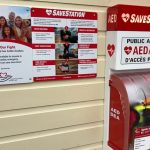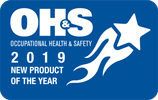Watch the video HERE
EASTON, Md. – While the thought of a loved one going into cardiac arrest can be terrifying, knowing you can potentially save someone before first responders ever arrive, can be a miracle. That’s why organizations in Talbot County are saving lives, one defibrillator at a time with their new ‘SaveStation’ project. “The quicker that someone has public access to AED for defibrillation, it can get their heart restarted again, that saves lives, that’s why this is so important,” says Rachael Cox, AED, CPR Program Coordinator, and Department of Emergency Services.
‘SaveStations’ are giving first responders a few extra minutes to respond, by adding another layer of protection for the community in case someone goes into cardiac arrest. “Cardiac arrest scenarios, for every minute cardiac arrest or CPR, is not performed, you’re losing about 10% of your brain, brain death can occur very quickly in a cardiac arrest scenario,” says Cox.
Through the work of Team Trace, and the Talbot Co. Paramedic Foundation, these stations have been a work in progress for years. “Between the two foundations, we can subsidize the purchase of save stations, and the placement of ‘SaveStations,” says, Wayne Dyott, President of the Talbot Co. Paramedic Foundation. He adds, “We wanted to make our public access AEDs more identifiable, and with that came standardizations. So no matter where people looked in our county for aid, they knew what the cabinet would look like and what the AED station would look like.”
With the help of Gunther Electric out of Wye Mills, MD, they’re providing the final electric service hook-ups as a donation. These stations can maintain a nearly constant temperature and are ready to be utilized 24/7. When it comes time for an emergency, the AED itself walks you through the steps of defibrillation, and emergency services will automatically be contacted and dispatched.
We’re told, in rural areas like Talbot County, it can be crucial when EMS can’t get there fast enough. “So if this public access AEDs are available to anyone to get to use, then there’s going to be more lives saved,” says Cox.
They’re placed in public areas such as Idlewood Park in Easton, where community members become first responders too. “We’ve had at least five or six documented saves in our community with our public access AEDs. That’s big to have that many saves in a small community like ours,” says Dyott. First responder, Matthew Watkins echoes that by saying, “Now this new partnership with team trace and the support of the county council is just making this community one of the safest communities in the nation.” Watkins tells us, he’s been in the county since 1996, and seeing the evolution of these safety measures is life changing.
Now the next step is getting more of these ‘SaveStations’ throughout the community, making everyone feel safer, and eventually more educated on first responder safety measures. “We want to be a leader, we wanted to be the leader because we found out that it works,” says Dyott. Cox adds, “We want to make sure the community is safe at all times when we’re not there and that’s what the project is for.”
Source: wmdt.com



